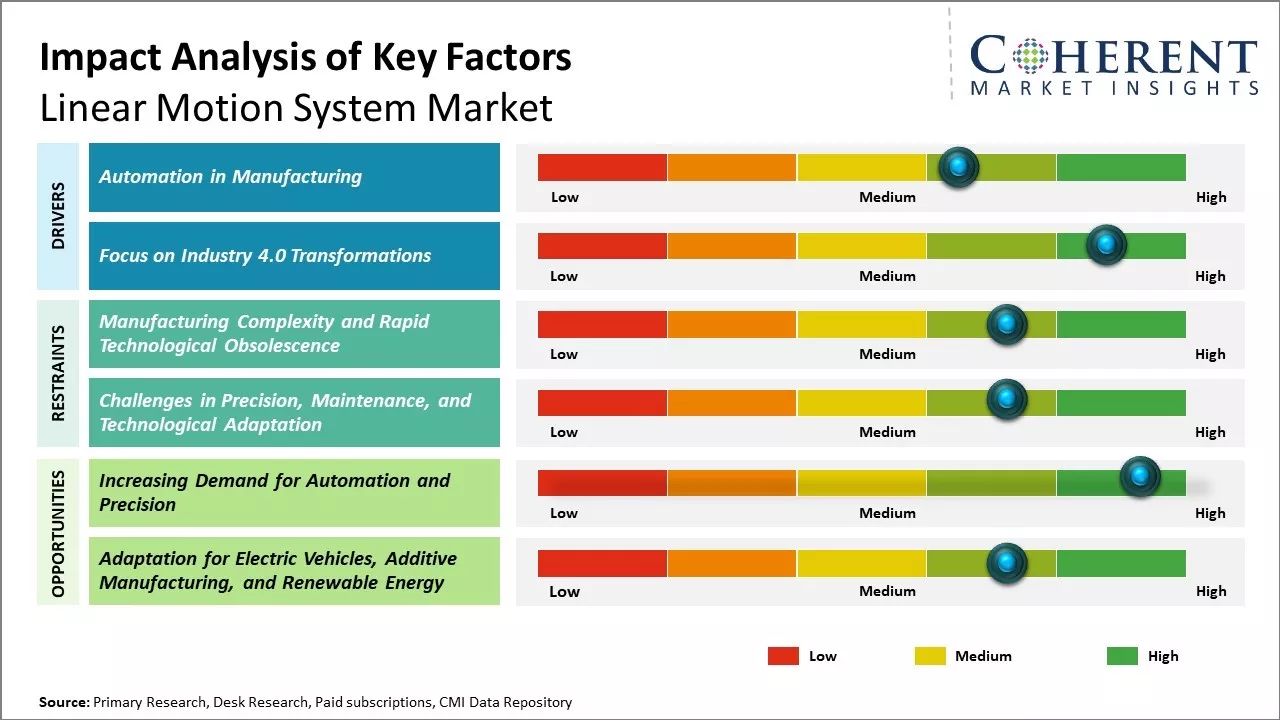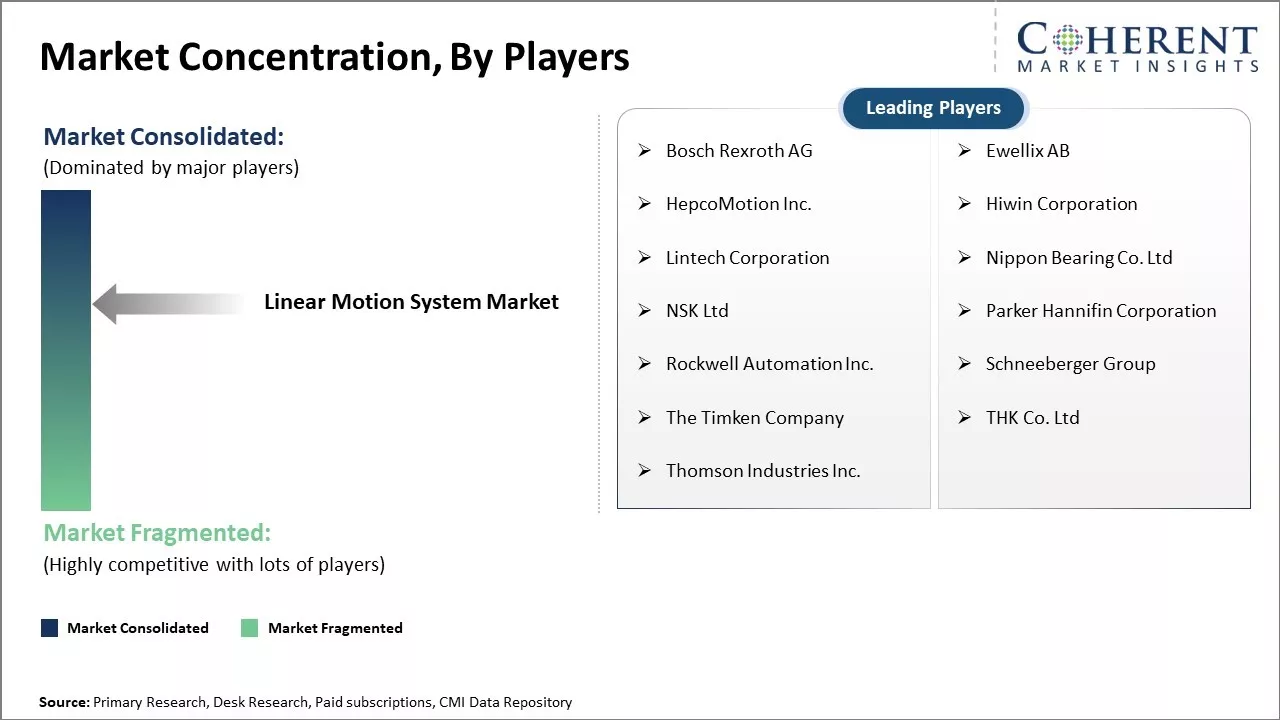
Global linear motion system market is estimated to be valued at USD 10.89 Bn in 2025 and is expected to reach USD 18.20 Bn by 2032, exhibiting a compound annual growth rate (CAGR) of 7.6% from 2025 to 2032.

Discover market dynamics shaping the industry: Download Free Sample
Global linear motion system market is expected to witness significant growth due to factors such as increasing industrial automation and emphasis on productivity. Linear motion system is increasing being used across automotive, electronics and semiconductors industries. Growing focus on precision and accuracy in manufacturing processes has also increased incorporation of linear motion systems. Furthermore, demand for electric loaders and baggage tug vehicles at airports is boosting prospects. However, availability of substitutes can hamper the market growth Advancements in componentry and emergence of smart industrial applications are expected to offer opportunities for linear motion system providers in the coming years.
Automation in Manufacturing
Rapid growth of industrial automation across various manufacturing sectors has boosted demand for linear motion systems over the past few years. Automation allows manufacturers to increase productivity while reducing costs by leveraging technologies such as robots, conveyor belts, actuators and other automated machinery that require precise linear motions. As labor costs continue to rise globally and the need to enhance manufacturing efficiencies becomes imperative, more companies are automating their production lines with automated guided vehicles, robotic arms, CNC machines and other automated systems that rely on linear motion guides, rails and actuators. This trend is expected to boost demand from industries such as automotive, semiconductor, electronics and others. With factories looking to implement Industry 4.0 standards and boost output with minimum human intervention, there has been increasing use of linear motion products. Leading automakers have already automated a major part of their vehicle assembly lines using linear robots for welding, painting and other applications. Manufacturers of smartphones, consumer electronics and semiconductor chips are heavily investing in automating repetitive, tedious production tasks through linear actuators integrated in pick-and-place, bonding and testing machines. The shift towards smart, connected and automated factories boost the integration of advanced linear motion technology.

Get actionable strategies to beat competition: Download Free Sample
Focus on Industry 4.0 Transformations
The emerging concept of Industry 4.0, with its emphasis on connectivity, digitization and data-driven manufacturing is compelling many companies to modernize their operations. A key aspect of the Industry 4.0 vision involves deploying technologies like collaborative robots, autonomous AGVs, IIoT sensor platforms and predictive maintenance solutions that rely on linear motion. Be it collaborative robot arms or conveyor belts outfitted with sensors, integrating linear motion capabilities is essential for enabling real-time machine-to-machine communication on the smart factory floor of tomorrow. Moreover, the use of linear position sensors, encoders and linear motors allow manufacturers to digitally track and manage assets with precision. This ability to gather and analyze granular operational data unlocks opportunities for remote monitoring, predictive quality control and spare parts management. As global manufacturers look to embrace the fourth industrial revolution, upgrading to smart, linear motion-powered automated systems and machinery will remain a high priority. While initial investments may be high, Industry 4.0 transformations are expected to deliver higher efficiencies, lower downtimes and improved decision making in the long run. The availability of plug-and-play
Key Takeaways from Analyst:
Global linear motion system market is expected to witness growth over the next few years. Growing automation across industries contributes to rising demand for linear motion systems. Advanced manufacturing technologies and robotics are increasingly adopting linear motion systems for precision movement in production lines. The need for automated machinery for improved productivity and reduced human errors is prompting manufacturing companies to invest in linear motion equipment. North America dominates the market due to extensive automotive and electronics manufacturing. However, Asia Pacific is expected to emerge as the fastest growing regional market with China and India taking the lead. While widespread industrial automation offers lucrative opportunities, high initial investment requirements can restrain the market' growth. Equipment manufacturers should focus on lowering the upfront equipment costs to attract price-sensitive customers. Ongoing innovation in actuator, drive and guidance technologies can expand the applications of linear motion systems beyond traditional industries. Adoption in relatively untapped sectors like food processing and logistics can offer market growth opportunities. Collaborations between motion control suppliers and system integrators can facilitate the development of customized solutions as per industry-specific workflow needs.
Market Challenges: Manufacturing Complexity and Rapid Technological Obsolescence
Precision and consistency are difficult to achieve at mass production scales, making the manufacturing of linear motion systems more complex and expensive. Maintenance of linear motion equipment requires downtime and replacement parts increases ongoing costs. Rapid changes in technology threaten obsolete existing system designs. Furthermore, significant capital investments and long replacement cycles hamper updated needed to integrate the latest technological advances.
Market Opportunities: Increasing Demand for Automation and Precision
The Automation across industries boosts demand for precise linear motion. Advanced material development allows for stronger, lighter, and more durable options. The Internet of Things enables collecting and analyzing usage data to optimize performance. Miniaturization of sensors and controls allow integrating linear motion into new applications. Adapting linear motion for electric vehicles, additive manufacturing, and renewable energy.

Discover high revenue pocket segments and roadmap to it: Download Free Sample
In terms of By Type, Widespread Industrial Applications
By type, single-axis linear motion system segment is estimated to contribute the highest market share of 64.7% in 2025, due to its versatility and broad usage across various industries. Single-axis system provides motion in only one direction along a line or rail. This simplicity makes single-axis motion well-suited for pickup-and-place processes on assembly lines. Common applications include transporting workpieces between process steps, sorting/inspection stations, and packaging operations.
Automotive industry's reliance on single-axis systems for moving vehicle components during assembly can also drive the segment growth. All major automakers leverage single-axis linear motors and guides to position dashboards, doors, and other parts into place with precision. The demand for electric and hybrid vehicles is also increasing usage, as their more complex powertrains require additional manufacturing steps handled by single-axis motion.
Outside of manufacturing, single-axis linear motion finds applications in areas like medical device production. From assembling components to automated testing and quality control, linear axes help streamline processes in operating rooms by providing repeatable, accurate motion. This enhances safety and efficiency in medical equipment construction.
Single-axis motion is vitally important for semiconductor fabrication, where it transports silicon wafers between process tools with microscopic precision. It also positions components during printed circuit board assembly and the construction of products like smartphones, televisions, and servers.
The widespread usage of single-axis linear motion across industries ensures its primacy in the market. Applications in diverse fields like automotive, medical, and electronics manufacturing depends on the simple, versatile motion provided by single-axis linear motion system. This boosts demand and makes the single-axis segment the largest portion of the linear motion system market.
In terms of By End-use Industry, Capital Intensive Nature and Reliance on Automation
By end-use industry, automotive segment is estimated to contribute the highest market share of 32.42% in 2025, due to its enormous scale and inherent demands for precision automation. Vehicle manufacturing requires complex assembly lines incorporating thousands of motion axes to weld, glue, paint, and install components with exacting standards.
Producing millions of vehicles per year makes automotive one of the most capital-intensive manufacturing sectors. Automakers strongly prioritize automation technologies to maximize throughput, reduce costs, and maintain quality control. Linear motion systems are essential for automating repetitive joining and positioning tasks that would be inefficient, dangerous, or impossible for human workers to perform manually at high volumes.
Modern automotive plants must accommodate a variety of vehicle models and options on the same assembly lines. Reconfigurable linear motion allows automakers to flexibly produce different vehicle types and handle production adjustments. This responsiveness to changing market demands is an important capability enabled by automated linear motion.
Linear guides and actuators also improve ergonomics and workplace safety in auto plants. Removing human laborers from repetitive, physically demanding tasks reduces the risk of injuries like muscular strain. The automation with linear motion improves precision and consistency as compared to manual labor, thus, enhancing component quality.
As electric vehicles witness huge popularity, the automotive industry's reliance on linear motion also increases. EV powertrains require additional manufacturing complexity that lends itself to automation solutions. This ensures automotive manufacturing remains the largest end-use industry of linear motion systems in the near future.

Need a Different Region or Segment? Download Free Sample
North America dominates the linear motion system market with the estimated market share of 30.3% in 2025, owing to strong presence of automated industrial equipment manufacturers in the region. The U.S. houses many large factories involved in automotive, electronics, food processing and other manufacturing industries. These factories extensively use automated assembly lines and material handling equipment installed with linear motion systems for precision operations. Availability of skilled workforce and technology leaders providing innovative linear motion solutions have helped establish North America's dominance.
The adoption of Industry 4.0 trends featuring robotics, IoT and AI boosts the use of automated systems in the region. Major industrial equipment providers based in North America are at the forefront of developing futuristic automated solutions featuring linear motion systems. This ensures steady demand from end-use industries looking to upgrade and integrate the latest technologies. With strong domestic demand and exports, North American linear motion system providers have established themselves as leaders in the global market as well.
Asia Pacific region holds immense potential and is emerging as the fastest growing market for linear motion system with the CAGR of 8.66% for the forecast period of 2025-2031. Countries like China, India, Japan and South Korea are industrial powerhouses with massive manufacturing output across industries. In recent years, these nations have witnessed rapid capacity additions and technology upgrades in their factories. This has significantly increased incorporation of automated systems utilizing linear motion.
Growing foreign investments and government initiatives promoting 'Made in India' and 'Made in China' have augmented domestic manufacturing capacities. With cost-competitive manufacturing environments, these regions have become top export hubs as well. Increasing labor costs are further driving the replacement of manual labor with automated systems relying on linear motion. Asian suppliers offering price competitive solutions have successfully penetrated international markets.
Linear Motion System Market Report Coverage
| Report Coverage | Details | ||
|---|---|---|---|
| Base Year: | 2024 | Market Size in 2025: | USD 10.89 Bn |
| Historical Data for: | 2020 To 2024 | Forecast Period: | 2025 To 2032 |
| Forecast Period 2025 to 2032 CAGR: | 7.6% | 2032 Value Projection: | USD 18.20 Bn |
| Geographies covered: |
|
||
| Segments covered: |
|
||
| Companies covered: |
Bosch Rexroth AG, Ewellix AB, HepcoMotion Inc., Hiwin Corporation, Lintech Corporation, Nippon Bearing Co. Ltd, NSK Ltd, Parker Hannifin Corporation, Rockwell Automation Inc., Schneeberger Group, The Timken Company, THK Co. Ltd, Thomson Industries Inc. |
||
| Growth Drivers: |
|
||
| Restraints & Challenges: |
|
||
Uncover macros and micros vetted on 75+ parameters: Get instant access to report
*Definition: Linear Motion System Market consists of components and assemblies that are designed to enable straight-line motion. This includes linear motion guides, linear actuators, linear motors, ball screws, linear ball bushings and linear roller bearings that aid precision linear movement in various industrial machinery, automation equipment, semiconductor fabrication equipment and inspection devices. Linear motion systems help provide smooth and accurate positioning for many manufacturing and assembly applications that require parts to move in a straight line for tasks like cutting, feeding, assembly and inspection.
Share
Share
About Author
Suraj Bhanudas Jagtap is a seasoned Senior Management Consultant with over 7 years of experience. He has served Fortune 500 companies and startups, helping clients with cross broader expansion and market entry access strategies. He has played significant role in offering strategic viewpoints and actionable insights for various client’s projects including demand analysis, and competitive analysis, identifying right channel partner among others.
Missing comfort of reading report in your local language? Find your preferred language :
Transform your Strategy with Exclusive Trending Reports :
Frequently Asked Questions
Joining thousands of companies around the world committed to making the Excellent Business Solutions.
View All Our Clients